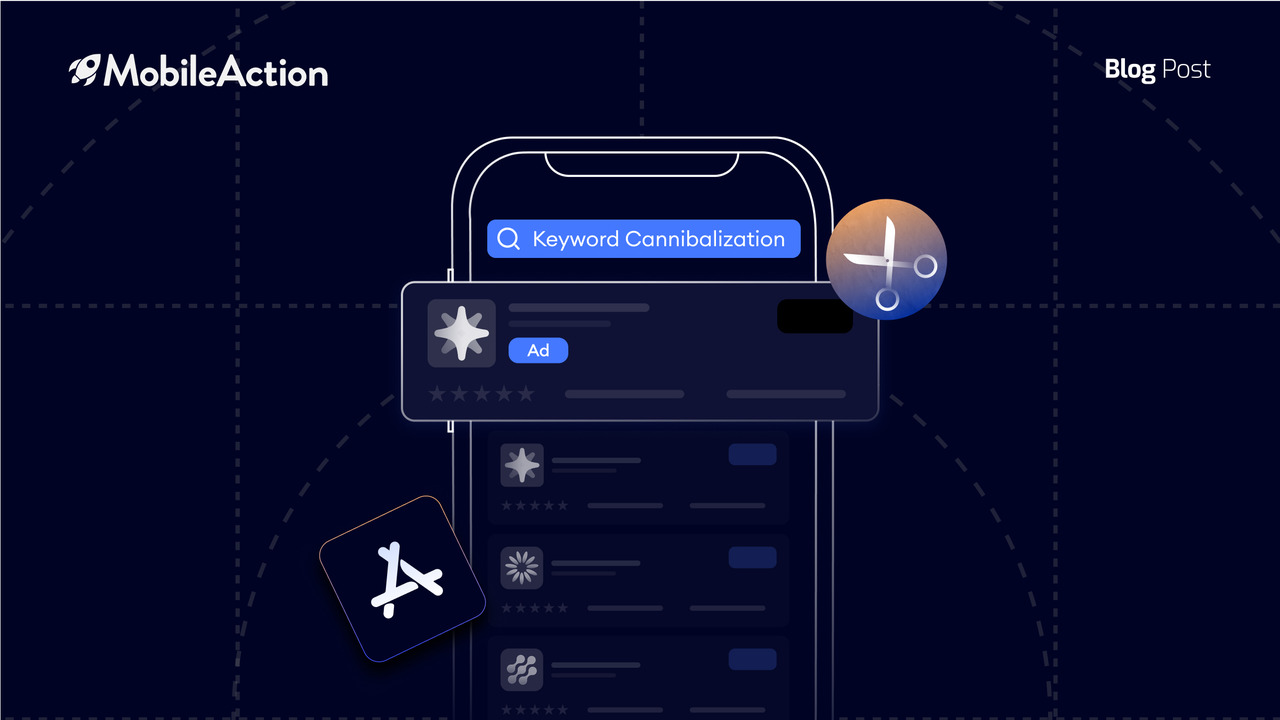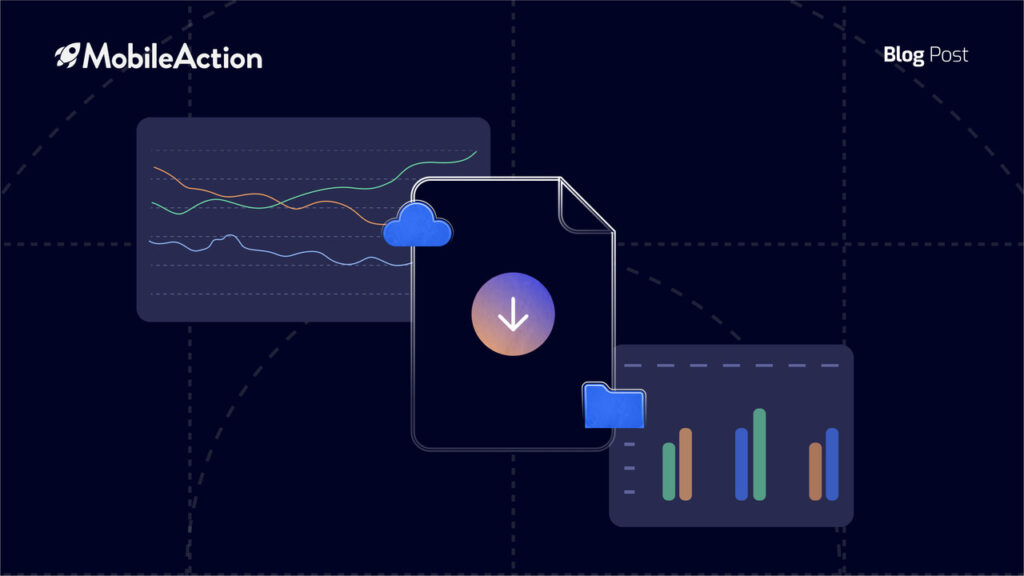Ever feel like your apps are fighting each other for downloads? If you’re an indie app developer or ASO agency managing multiple apps, you might be suffering from ASO keyword cannibalization without even realizing it.
In 2025, the app stores are more crowded than ever, and the last thing you need is your own apps competing against each other.
We will explain what ASO keyword cannibalization is, why it happens (especially when you have more than one app), how it hurts your rankings, and what you can do to fix it.
What is ASO keyword cannibalization?
ASO keyword cannibalization happens when your own apps unintentionally compete with each other by targeting the same keywords.
In simple terms, it means multiple apps from the same developer (or agency portfolio) are using the same search terms, and thus “eating” into each other’s rankings.
Picture it as siblings fighting over the TV remote — everyone loses! Instead of one app ranking strongly for a keyword, you have two or more of your apps splitting the relevance and clicks, resulting in none of them performing as well as they could.
This phenomenon is like having two storefronts next to each other selling the exact same goods. You’d hope to dominate the block, but in reality you’re just dividing your customer traffic between the two.
In the context of App Store Optimization (ASO), cannibalization dilutes each app’s visibility. Your app listings start competing with each other rather than against your real competitors, which can lower the visibility and downloads for all apps involved.
In the end, ASO keyword cannibalization means you’re undermining your own ASO efforts by overcrowding the same keyword space with your own apps.
How and why does ASO keyword cannibalization happen?
ASO keyword cannibalization typically happens when there’s overlap in the keywords and audience that multiple apps are targeting.
This often boils down to a lack of strategic planning or differentiation. Here are some common reasons this internal competition occurs:
- Keyword Overlap: The most frequent cause is when multiple apps target the same high-value keywords. For instance, you publish two photo editing apps and use keywords like “photo editor” and “filters” for both. They’ll inevitably compete for the same search queries.
- Similar App Functionality: If your apps have similar features or serve similar user needs, they’re likely to naturally end up targeting the same or very similar keywords. An indie dev might create two puzzle games or two productivity tools that inadvertently go after the same audience.
- Multiple Apps, One Strategy: Sometimes agencies or developers reuse a “proven” keyword strategy across apps. It might seem efficient, but if each app listing isn’t differentiated, you create internal competition.
- Lack of Communication or Planning: In a team or agency scenario, cannibalization can occur simply because of poor coordination – e.g., one team works on App A and another on App B, and both end up optimizing for the exact keywords in isolation. Without a unified plan, overlap is almost guaranteed.
- Chasing the Same Trends: In 2025, apps often pivot quickly to chase trending keywords (think “AI” or “ChatGPT” related terms). If you have multiple apps and you add the hot new buzzword to all their metadata, they might all collide on that term in the store search results.
- Limited Market Segmentation: If you haven’t clearly defined different target users or niches for each app, you might be aiming all your apps at the same broad audience. This means identical keywords and messaging that cause cannibalization.
It’s worth noting that some companies intentionally pursue a strategy known as “road blocking,” where they use the same keywords across multiple apps to occupy more spots in search results.
This approach can push competitors down and show several of your apps to users (for example, dominating the ‘Similar Apps’ suggestions with your portfolio).
However, for most indie developers and small studios, this tactic can backfire.
Unless each app has a distinct identity and purpose, you’ll more likely cannibalize your own traffic than achieve any meaningful “domination.”
How to fix ASO keyword cannibalization in 2025
The good news is that you can avoid competing with yourself by being strategic. Here are some effective solutions to prevent or fix ASO keyword cannibalization in your app portfolio:
Conduct a keyword audit & differentiate your keywords
Start by auditing the keywords for all your apps. List out what keywords each app is targeting (in the title, subtitle, keyword field, description, etc.).
This will reveal any overlapping terms. Once you spot overlaps, decide which app should “own” which keywords.
The aim is to prevent ASO keyword cannibalization by making sure each app listing focuses on different, relevant keywords, which in turn improves visibility and downloads.
Differentiate each app’s purpose and messaging
It’s crucial that each app has its own clear value proposition and unique features. Ask yourself: what does App A offer that App B doesn’t (and vice versa)? Highlight that.
Make sure your app titles, subtitles, and descriptions emphasize different strengths. This not only helps users choose the app that fits their needs, but it also naturally leads to using different keywords.
If one of your apps is a “light” version and another is “pro”, clarify that.
Segment your audience
Think about who the ideal user is for each app. Even if two of your apps are in the same broad category, they might serve different segments.
For instance, one fitness app might be for beginners and another for advanced athletes.
In your ASO, target different user intents – the beginner app could focus on “easy workouts” keywords, while the advanced one targets “HIIT training” keywords.
By segmenting your audience, you ensure each app goes after a distinct set of search terms relevant to that group.
Plan your metadata and updates strategically
Instead of optimizing each app in a vacuum, plan your metadata updates with a holistic view. Avoid using the exact same high-value keyword in multiple apps’ titles or subtitles.
You can even create an internal keyword map – a simple spreadsheet listing all your apps and their target keywords to ensure there’s no unintended overlap.
As the app stores evolve in 2025, it’s wise to monitor changes; sometimes a keyword that wasn’t causing cannibalization before might start to if an algorithm tweak makes apps with the same publisher more likely to be compared.
Stagger and strategize app launches
If you’re launching or updating multiple apps, be mindful of timing and focus. Releasing two very similar apps around the same time can set them up to clash from day one.
Whenever possible, carefully plan the release schedule for your apps.
Give one app time to establish itself with a certain audience and keyword set before pushing another app that’s close in genre.
This way, you can accumulate learnings from the first app’s ASO performance and adjust the second app’s strategy to avoid direct competition.
Leverage cross-promotion wisely (Not Blindly)
Having multiple apps isn’t inherently a bad thing – it can be an advantage if you cross-promote properly.
But ensure cross-promotion is about guiding users to distinct experiences rather than bouncing them between interchangeable apps. For instance, use in-app banners or links to recommend your other apps only when they fill a different need.
If done right, a user who came for one app might discover your other app and use both because they serve different purposes. This way, you’re turning what could have been cannibalization into synergy.
Monitor performance and adjust
Prevention isn’t a one-and-done deal. Continuously monitor your apps’ keyword rankings and download trends.
If you notice a sudden drop in one app’s ranking for a keyword after launching or updating another app, that’s a red flag.
Regularly analyze if two or more apps from your portfolio are targeting the same keywords – it’s a clear warning sign.
You can even calculate a simple “cannibalization rate” as the percentage of keywords your apps share.
By following these steps, you can significantly reduce ASO keyword cannibalization and even turn a multiple-app portfolio into an advantage.
The goal is to have each of your apps capture its own slice of the market without stepping on each other’s toes.
Instead of cannibalizing, your apps can complement each other – for example, one app might rank high for one set of keywords, while another app from your stable ranks for a different set, giving your brand broader overall coverage.
The bottom line
The app market isn’t getting any less competitive – with millions of apps out there, you need every edge you can get.
Don’t let your own apps drag each other down. By eliminating ASO keyword cannibalization in your portfolio, you’ll likely see improved rankings, more organic installs, and a clearer brand identity across your apps.
Consider this your 2025 ASO resolution: stop competing with yourself. Optimize smarter, not harder, and watch your apps thrive without stepping on each other’s toes.
Now go forth and reclaim those lost downloads – your future self (and your download stats) will thank you for it!






